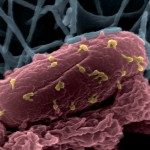Link to Pubmed [PMID] – 24041900
Antimicrob. Agents Chemother. 2013 Dec;57(12):5961-8
The potential of bacteriophage therapy to treat infections caused by antibiotic-resistant bacteria has now been well established using various animal models. While numerous newly isolated bacteriophages have been claimed to be potential therapeutic candidates on the basis of in vitro observations, the parameters used to guide their choice among billions of available bacteriophages are still not clearly defined. We made use of a mouse lung infection model and a bioluminescent strain of Pseudomonas aeruginosa to compare the activities in vitro and in vivo of a set of nine different bacteriophages (PAK_P1, PAK_P2, PAK_P3, PAK_P4, PAK_P5, CHA_P1, LBL3, LUZ19, and PhiKZ). For seven bacteriophages, a good correlation was found between in vitro and in vivo activity. While the remaining two bacteriophages were active in vitro, they were not sufficiently active in vivo under similar conditions to rescue infected animals. Based on the bioluminescence recorded at 2 and 8 h postinfection, we also define for the first time a reliable index to predict treatment efficacy. Our results showed that the bacteriophages isolated directly on the targeted host were the most efficient in vivo, supporting a personalized approach favoring an optimal treatment.




